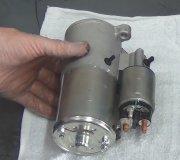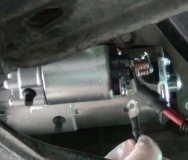The starter solonoid is still trying to start the car. This could be because its was stuck. Now I suspect it has burnt out. The cause of this could be a bad connection at starter wires or a faulty ignition switch.
TESTING (ON-VEHICLE)
CAUTION:Ensure transmission is in Park on A/T models or Neutral on M/T models prior to testing starter.
STARTER RELAY TEST
If vehicle will not start and battery is fully charged, remove Red/Blue wire connector from starter relay. Ensure connection is clean and secure and relay bracket is securely grounded.
If starter still will not operate, connect jumper wire between Red/Blue wire connector of starter relay and positive battery terminal. Ensure transmission is in Park on A/T models or Neutral on M/T models.
If relay operates, check ignition, neutral safety or clutch switch operation and wiring circuits. Replace relay if it failed to operate with jumper wire.
LOAD TEST
Connect starter load tester on battery terminals. Ensure no current is flowing through the ammeter and carbon pile of tester. Disconnect terminal "S" of starter relay.
Connect remote starter switch between terminal "S" and positive battery terminal. Ensure transmission is in Park on A/T models or Neutral on M/T models prior to testing starter.
Crank engine with ignition off and note voltmeter reading. Stop cranking engine. Turn tester carbon pile to achieve voltage obtained while cranking. Note ammeter reading. Replace or repair starter if current exceeds specification. See STARTER SPECIFICATIONS table.
Fig. 1: Starter Load Test Connections
TESTING (OFF-VEHICLE)
NO-LOAD TEST
Connect battery, jumper cables and starter tester to starter. See Fig. 1. Ensure no current is flowing through the ammeter and carbon pile of tester.
Operate starter and note voltmeter reading. Disconnect battery from starter. Turn carbon pile to achieve voltage obtained while starter was operating. Note ammeter reading. Replace or repair starter if current exceeds specification. See STARTER SPECIFICATIONS table.
ARMATURE OPEN CIRCUIT TEST
An open armature circuit can be detected by inspecting the commutator for evidence of burning. If burning is present, replace armature assembly. Check for damage to other related components.
ARMATURE & FIELD GROUNDED CIRCUIT TEST
Connect voltmeter and battery terminals to components. See Fig. 2. If voltmeter shows any voltage, windings are grounded.
Fig. 2: Armature & Field Grounded Circuit Tests
REMOVAL & INSTALLATION
Disconnect battery ground cable. Raise vehicle. Disconnect relay to starter cable at starter. Remove starter mounting bolts and ground cable. Remove starter from vehicle. To install, reverse removal procedure. Tighten bolts or nuts to specifications.
OVERHAUL
During disassembly, note location of brush holder with respect to end terminal. On field coil which operates drive gear actuating lever, bend edges on field coil retaining sleeve and remove sleeve and retainers. Cut positive brush leads from field coils as close to field connection point as possible.
During reassembly, replace brushes using a 300-watt soldering iron and rosin core solder. Lubricate armature shaft splines with Lubriplate. Fill drive end housing bearing bore with Grease (ESB-M1C63-A) approximately 1/4 full. Tighten through bolts to 55 INCH lbs. (6-2 N.M).
Sunday, November 16th, 2008 AT 1:41 PM



